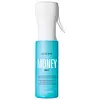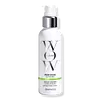What's inside
What's inside
 Benefits
Benefits

 Concerns
Concerns

 Ingredients Side-by-side
Ingredients Side-by-side

Water
Skin ConditioningButylene Glycol
HumectantBehentrimonium Chloride
PreservativeCetyl Alcohol
EmollientPolyquaternium-55
Hydrolyzed Rice Protein
Skin ConditioningAdansonia Digitata Seed Extract
Skin ConditioningAmaranthus Caudatus Seed Extract
Skin ConditioningPropanediol
SolventStearamidopropyl Dimethylamine
EmulsifyingStearyl Alcohol
EmollientDicetyldimonium Chloride
EmulsifyingHydrolyzed Vegetable Protein Pg-Propyl Silanetriol
Skin ConditioningCrambe Maritima Leaf Extract
Skin ConditioningChlorella Pyrenoidosa Extract
Skin ConditioningChondrus Crispus Extract
Skin ConditioningUndaria Pinnatifida Extract
Skin ConditioningLaminaria Saccharina Extract
Skin ProtectingParfum
MaskingCeteareth-20
CleansingCaprylyl Glycol
EmollientPhenoxyethanol
PreservativeCitric Acid
BufferingPotassium Benzoate
PreservativeDimethicone
EmollientPotassium Sorbate
PreservativePropylene Glycol
HumectantSodium Benzoate
MaskingDisodium EDTA
Isopropyl Alcohol
SolventBenzyl Salicylate
PerfumingAlpha-Isomethyl Ionone
PerfumingWater, Butylene Glycol, Behentrimonium Chloride, Cetyl Alcohol, Polyquaternium-55, Hydrolyzed Rice Protein, Adansonia Digitata Seed Extract, Amaranthus Caudatus Seed Extract, Propanediol, Stearamidopropyl Dimethylamine, Stearyl Alcohol, Dicetyldimonium Chloride, Hydrolyzed Vegetable Protein Pg-Propyl Silanetriol, Crambe Maritima Leaf Extract, Chlorella Pyrenoidosa Extract, Chondrus Crispus Extract, Undaria Pinnatifida Extract, Laminaria Saccharina Extract, Parfum, Ceteareth-20, Caprylyl Glycol, Phenoxyethanol, Citric Acid, Potassium Benzoate, Dimethicone, Potassium Sorbate, Propylene Glycol, Sodium Benzoate, Disodium EDTA, Isopropyl Alcohol, Benzyl Salicylate, Alpha-Isomethyl Ionone
Water
Skin ConditioningBehentrimonium Methosulfate
Cetyl Alcohol
EmollientCaprylic/Capric Triglyceride
MaskingPolyquaternium-37
Glycerin
HumectantButylene Glycol
HumectantPhenoxyethanol
PreservativeSilicone Quaternium-18
EmollientPropylene Glycol Dicaprylate/Dicaprate
EmollientCaprylyl Glycol
EmollientCeteareth-20
CleansingPPG-26-Buteth-26
Skin ConditioningPEG-40 Hydrogenated Castor Oil
EmulsifyingParfum
MaskingTrideceth-6
EmulsifyingPPG-1 Trideceth-6
Skin ConditioningTrideceth-12
EmulsifyingCrambe Maritima Leaf Extract
Skin ConditioningAscophyllum Nodosum Extract
Skin ConditioningBenzyl Salicylate
PerfumingLinalool
PerfumingLimonene
PerfumingWater, Behentrimonium Methosulfate, Cetyl Alcohol, Caprylic/Capric Triglyceride, Polyquaternium-37, Glycerin, Butylene Glycol, Phenoxyethanol, Silicone Quaternium-18, Propylene Glycol Dicaprylate/Dicaprate, Caprylyl Glycol, Ceteareth-20, PPG-26-Buteth-26, PEG-40 Hydrogenated Castor Oil, Parfum, Trideceth-6, PPG-1 Trideceth-6, Trideceth-12, Crambe Maritima Leaf Extract, Ascophyllum Nodosum Extract, Benzyl Salicylate, Linalool, Limonene
Ingredients Explained
These ingredients are found in both products.
Ingredients higher up in an ingredient list are typically present in a larger amount.
Benzyl Salicylate is a solvent and fragrance additive. It is an ester of benzyl alcohol and salicylic acid. This ingredient can be naturally found in some plants and plant extracts.
In fragrances, Benzyl Salicylate may be a solvent or a fragrance component. In synthetic musk scents, it is used as a solvent. For floral fragrances such as lilac and jasmine, it is used as a fragrance component. The natural scent of Benzyl Salicylate is described as "lightly-sweet, slightly balsamic".
While Benzyl Salicylate has been associated with contact dermatitis and allergies, emerging studies show it may not be caused by this ingredient alone.
However, this ingredient is often used with fragrances and other components that may cause allergies. It is still listed as a known allergen in the EU. We recommend speaking with a professional if you have concerns.
Another study from 2021 shows Benzyl Salicylate may have anti-inflammatory properties.
Learn more about Benzyl SalicylateButylene Glycol (or BG) is used within cosmetic products for a few different reasons:
Overall, Butylene Glycol is a safe and well-rounded ingredient that works well with other ingredients.
Though this ingredient works well with most skin types, some people with sensitive skin may experience a reaction such as allergic rashes, closed comedones, or itchiness.
Learn more about Butylene GlycolCaprylyl Glycol is a humectant and emollient, meaning it attracts and preserves moisture.
It is a common ingredient in many products, especially those designed to hydrate skin. The primary benefits are retaining moisture, skin softening, and promoting a healthy skin barrier.
Though Caprylyl Glycol is an alcohol derived from fatty acids, it is not the kind that can dry out skin.
This ingredient is also used as a preservative to extend the life of products. It has slight antimicrobial properties.
Learn more about Caprylyl GlycolCeteareth-20 is an emulsifier and cleansing agent. It is derived from cetearyl alcohol, a fatty alcohol.
As an emulsifier, Ceteareth-20 prevents oil and water from separating. It is also a surfactant. Surfactants help gather oil, pollution, and dirt to be washed away.
Cetyl Alcohol is a fatty alcohol. Fatty Alcohols are most often used as an emollient or to thicken a product.
Its main roles are:
Though it has "alcohol" in the name, it is not related to denatured alcohol or ethyl alcohol.
The FDA allows products labeled "alcohol-free" to have fatty alcohols.
Learn more about Cetyl AlcoholWe don't have a description for Crambe Maritima Leaf Extract yet.
Parfum is a catch-all term for an ingredient or more that is used to give a scent to products.
Also called "fragrance", this ingredient can be a blend of hundreds of chemicals or plant oils. This means every product with "fragrance" or "parfum" in the ingredients list is a different mixture.
For instance, Habanolide is a proprietary trade name for a specific aroma chemical. When used as a fragrance ingredient in cosmetics, most aroma chemicals fall under the broad labeling category of “FRAGRANCE” or “PARFUM” according to EU and US regulations.
The term 'parfum' or 'fragrance' is not regulated in many countries. In many cases, it is up to the brand to define this term.
For instance, many brands choose to label themselves as "fragrance-free" because they are not using synthetic fragrances. However, their products may still contain ingredients such as essential oils that are considered a fragrance by INCI standards.
One example is Calendula flower extract. Calendula is an essential oil that still imparts a scent or 'fragrance'.
Depending on the blend, the ingredients in the mixture can cause allergies and sensitivities on the skin. Some ingredients that are known EU allergens include linalool and citronellol.
Parfum can also be used to mask or cover an unpleasant scent.
The bottom line is: not all fragrances/parfum/ingredients are created equally. If you are worried about fragrances, we recommend taking a closer look at an ingredient. And of course, we always recommend speaking with a professional.
Learn more about ParfumPhenoxyethanol is a preservative that has germicide, antimicrobial, and aromatic properties. Studies show that phenoxyethanol can prevent microbial growth. By itself, it has a scent that is similar to that of a rose.
It's often used in formulations along with Caprylyl Glycol to preserve the shelf life of products.
Water. It's the most common cosmetic ingredient of all. You'll usually see it at the top of ingredient lists, meaning that it makes up the largest part of the product.
So why is it so popular? Water most often acts as a solvent - this means that it helps dissolve other ingredients into the formulation.
You'll also recognize water as that liquid we all need to stay alive. If you see this, drink a glass of water. Stay hydrated!
Learn more about Water